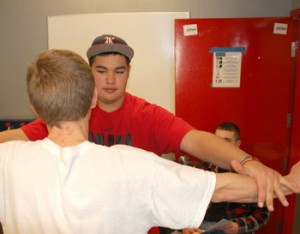When Troy Stoops was the principal at Kennedy High School, he was always looking for ways to tweak the curriculum and boost student interest and enthusiasm.
Stoops, who is now the superintendent, hit the jackpot in this effort when he hired Jeff Crapper as a teacher three years ago. Knowing that Crapper not only was an athletic trainer, but also had a background in teaching sports medicine at Sherwood schools, Stoops asked him to start a Sports Medicine class at Kennedy for the 2009-10 school year.
The program took off, and has evolved far beyond Stoops’ original vision. Kennedy’s program is not only popular and growing, but is being viewed as a potential model for small schools in Oregon and the nation.
Crapper worked collaboratively with science teacher Carlie Harris, another innovative Kennedy teacher, to establish a Career Technical Education program of study with both engineering and biomedical tracks. They pulled in around $70,000 in grants for the program in just the past six months.
“This is one of those programs where, if you have competent teachers who are willing to go the extra mile to implement it, there’s resources available,” Stoops said. “As a result, we’re offering programs that are cutting edge in technology and science. I think it could create a real model, especially for small schools like we are . . . Jeff and Carlie have both done an outstanding job.”
Stoops made the decision in 2009 to replace a science/agriculture-split teaching position with a science/sports medicine position in order to give Kennedy students the opportunity to gain experience in health science careers.
After an initial success with the “basic” Sports Medicine class, last year Kennedy added an “advanced” class and a practicum in sports medicine. Crapper said Kennedy students, through the school’s partnership with Chemeketa Community College, can earn “up to 19 credits in sports medicine and those will transfer to any medical-related training program.”
Senior Mike Farris has been involved with the sports medicine program at Kennedy since its inception and is now in his fourth semester of practicum work. Farris has assisted several of the sports programs at the school with athletic training needs. He was even able to help with injuries in football this year while playing on the team.
“I love (the program),” Farris said. “It is a lot of fun and really good experience for anyone who wants to go into the medical field and anyone who needs (to earn) volunteer hours. It’s made health classes easy for me . . . We have learned a lot of stuff in practicum that is taught in anatomy class. When you take classes like this you know so much more and you can really help people when they need it.”
Responses like that are music to the ears of educators.
“This program helps kids get real-life exposure to those skills, and also increases their academic interest, which is our ultimate goal. They move forward, begin to set goals and work hard to achieve them,” Stoops said.
Both Stoops and Crapper said the program is still evolving and more “career pathways” are being created.
As a part of the new curriculum, a Public Service career pathway has also been added this year. Firefighting and emergency medical technician work are among the careers covered in three classes that are being taught by Harris, Crapper and Kevin Moffatt.
Through “Project Lead the Way,” a national nonprofit promoting innovation in engineering and biomedical sciences, Kennedy is considered a “lead school.” When the biomedical and engineering classes are fully in place, Kennedy will be the second high school in Oregon to offer both tracks. The only other school offering both is Beaverton Health and Science High School. Crapper said that other schools from as far away as Alaska are asking for information.
“The Biomedical Science program we will be adding next year is almost like a pre-nursing program,” Crapper said. Courses to be added include Human Body Systems, Medical Interventions, and Biomedical Innovations.
There are five courses in the Engineering Sciences track. Two of them, Aerospace Engineering and Digital Electronics, are taught through Chemeketa Community College and Evergreen Aviation Museum as part of the Chemeketa STEM program. Both courses are taught off-site, but a grant provides transportation for Kennedy students to attend these classes in McMinnville on weekends.
The Engineering Sciences track will also include Introduction to Engineering Design, Principles of Engineering, and Engineering Design & Development. The Intro class is designed for freshmen and sophomores, while Principles and Digital Electronics are targeted to sophomores and juniors. Engineering Design and Development, offered to seniors, is an “engineering research course in which students will work in teams to research, design, test and construct a solution to an open-ended engineering problem.”
With so many exciting innovations going on at Kennedy, one has to ask what the impact of budget cuts and constraints will be. Will the new programs be threatened by the fiscal problems schools are facing?
“Budgetarily, everything is threatened,” Stoops said. “Anything (we offer) is in jeopardy right now, outside of your required courses. But one of the things they have done is to transform required classes, so that kids are getting Project Lead the Way information in a required course. So, that’s how it will sustain itself.”
Stoops also notes that these courses are closely tied in to current developments in the fields being studied and students get to see how knowledge is being used in actual work settings.
“They get excited when they see that.”
